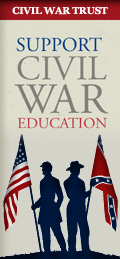African American Faces of the Civil War: An Album
Illustrated, photos, notes, bibliography, index, 384 pp., 2012, Johns Hopkins, www.press.jhu.edu, $29.95.
Augustus Saint-Gaudens unveiled his Boston monument to Col. Robert Gould Shaw and the 54th Massachusetts on May 31, 1897, to commemorate the heroic deeds of Shaw and his regiment.
However, Saint-Gaudens’ memorial contains a historical irony: the faces, excluding Shaw’s, were not modeled after one single member of the original 54th or any other African American who served in the Civil War. The sculptor hired models to pose as subjects.
While the monument memorializes Shaw, it makes the regiment he commanded faceless to posterity and relegates the members to a place where most of the nearly 200,000 African Americans who served in the Union army and navy have ended — historical obscurity. Fortunately, Ronald S. Coddington has rescued scores of African-American faces from historical anonymity with his recent volume.
Coddington, the author of two previous collections of Civil War photographs and a columnist for Civil War News, first considered a collection of African-American photographs in 2004.
For several years he tracked down the 77 photographs in the book. Then he undertook the laborious task of culling through source materials at the National Archives and Library of Congress to piece together the remarkable stories of African Americans who played a role in the most pivotal event of our republic’s history.
While Coddington includes several photographs and biographical vignettes about some men who are more well-known, such as Maj. Martin Delaney, Nick Biddle, Robert Smalls, Sgt. William Carney and Sgt. Maj. Lewis Douglass, the focus of his book is on the varied experiences and contributions of individuals who, before this volume, lived in the historical shadows.
Coddington’s careful selection of photographs illustrates that although African Americans who supported the Union war effort shared the ultimate goal of social and political equality, they took very different paths to Union service.
A large number ran away from their masters when Union forces were near. Such was the case with Silas Brown, a slave in the Mississippi Delta who ran away from Alterra plantation and enlisted in the 96th U.S. Colored Troops (USCT).
For John Goosberry, a veteran of the 54th Massachusetts, the path to enlistment was markedly different. Goosberry, as the author so masterfully writes, was a slave who escaped bondage in New Orleans and fled to Canada before the conflict.
Although life in Canada secured his freedom, Goosberry believed it only right to return to the United States and enlist in the 54th Massachusetts to aid other African Americans in their quest for what he had already enjoyed — freedom.
Other African Americans came to service as substitutes for unwilling white persons drafted into the Union army. Such was the case with Pvt. Allen King of the 122nd USCT, who served as the substitute for Dr. John Clemens, author Mark Twain’s cousin.
In addition to discussing the diverse paths to enlistment and the ways in which individuals such as Robert Holloway, body servant to Gen. Ambrose Burnside, contributed to the war effort, Coddington reminds us that both African Americans and their white officers realized that education was an essential tool in realizing freedom.
His examination of the 62nd USCT’s Sgt. Octavius McFarland and the efforts of the regiment’s white officers to organize a writing and reading competition stands as a stark reminder of the powerful relationship between education and freedom.
Historians who wish to understand the Civil War’s global meaning will find the piece on Sgt. Maj. Charles W. Singer most insightful. From Singer’s perspective, the war against slavery should not only have been waged for the benefit of African Americans in the United States, but to offer hope to oppressed peoples around the globe.
Coddington’s thoughtfully crafted and cogently written study, replete with an insightful foreword by J. Matthew Gallman on the African-American experience, will appeal to readers interested in the efforts of African Americans and the war’s larger military, social and global consequences.
Jonathan A. Noyalas
Jonathan A. Noyalas is assistant professor of history and director of the Center for Civil War History at Lord Fairfax Community College in Middletown, Va., and the author or editor of eight books on Civil War era history.
|
